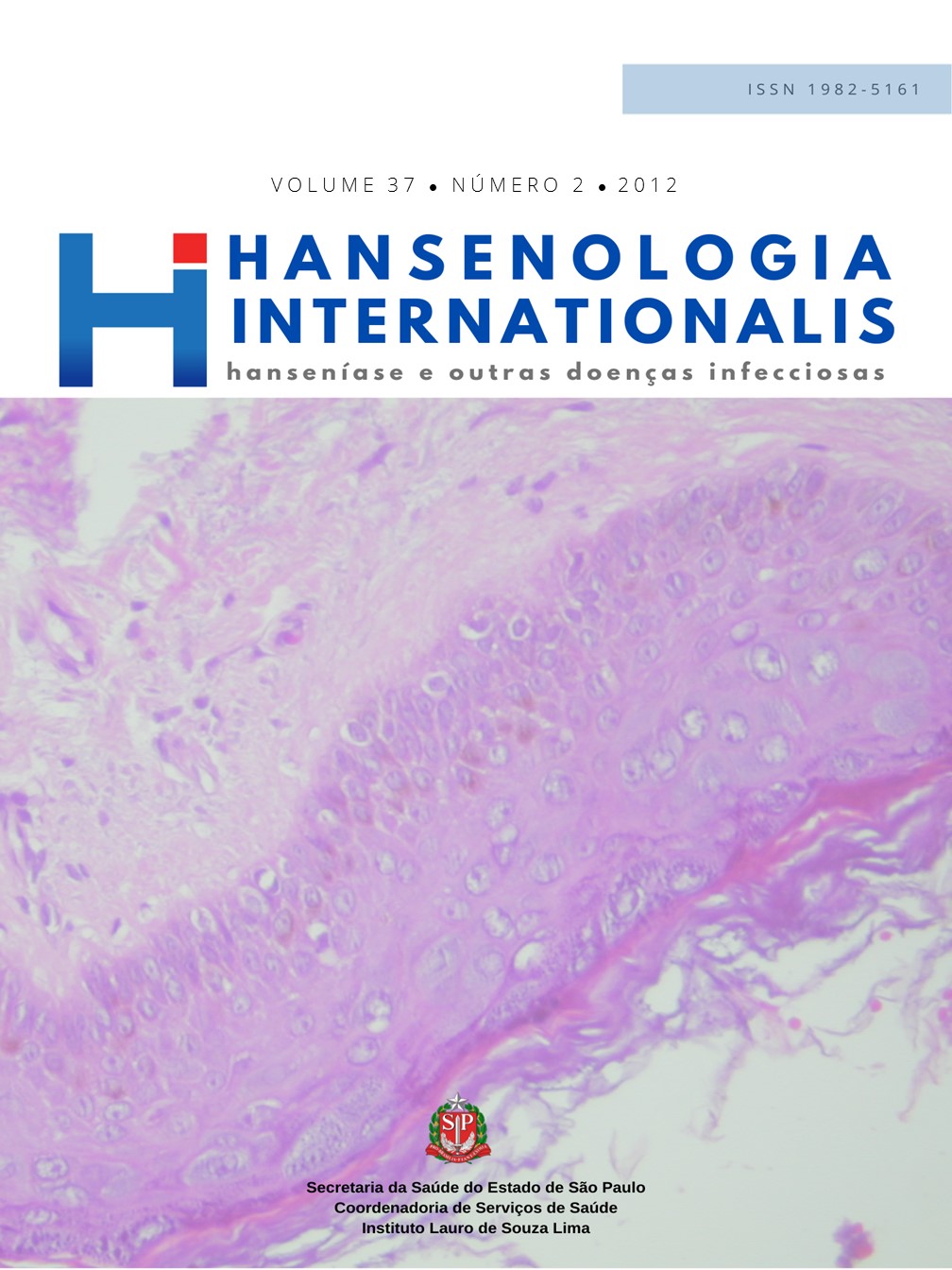Abstract
Leptin, an adipokine with structural and functional similarities to proinflammatory cytokines that contributes to the differentiation of T helper-1 cells, seems to be involved in the immune response to infectious agents. In leprosy, a chronic infectious disease caused by Mycobacterium leprae, whose clinical manifestations dependon the host immune response, there are no reports on the role of leptin. In this pilot study the serum leptin levels were quantified in newly diagnosed patients with different clinical forms of leprosy, patients with type 1 and 2 reaction, contacts of leprosy patients and healthy controls (237 serum samples:165 men and 72 women). In males, TT and BB patients showed concentrations close to those observed in controls while groups I, BT, BV, VV, type 1 and 2 reactional patients had lower means in comparison to controls and contacts, whereas in BV and VV patients it were observed the lowest levels of leptin. In females, we found a wide variation between the values observed in the different groups. The BV group had higher levels of leptin while groups I, TT, BT and BB had averages closed to that observed in contacts and controls. The differences observed in both men and women were not statistically significant. Our findings show a tendency to lower levels of leptin in multibacillary patients, however, these results do not allow any association of leptin with leprosy clinical forms.
References
2 Hossner KL. Cellular, molecular and physiological aspects of leptin: Potential application in animal production. Can J Anim Sci. 1998, 78:463-472.
3 Lam QL, Lu L. Role of leptin in immunity. Cell Mol Immunol. 2007 Feb;4(1):1-13.
4 La Cava A, Matarese G. The weight of leptin in immunity. Nat Rev Immunol. 2004 May;4(5):371-9.
5 Hsu A, Aronoff DM, Phipps J, Goel D, Mancuso P. Leptin improves pulmonary bacterial clearance and survival in ob/ob mice during pneumococcal pneumonia, Clin Exp Immunol, 2007; 150(2):332-9.
6 Prabha C, Karthic S, Das SD, Swaminathan S, Subramaniam S, Sukumar B. Impact of tuberculosis on serum leptin levels in patients with HIV infection. Horm Res. 2005;63(5):228-33.
7 Nagajyothi F, Zhao D, Machado FS, Weiss LM, Schwartz GJ, Desruisseaux MS, et al. Crucial role of the central leptin receptor in murine Trypanosoma cruzi (Brazil strain) infection. J Infect Dis. 2010 Oct 1;202(7):1104-13.
8 Ikejima S, Sasaki S, Sashinami H, Mori F, Ogawa Y, Nakamura T, et al. Impairment of host resistance to Listeria monocytogenes infection in liver of db/db and ob/ob mice. Diabetes. 2005 Jan;54(1):182-9.
9 Wieland CW, Florquin S, Chan ED, Leemans JC, Weijer S, Verbon A, et al. Pulmonary Mycobacterium tuberculosis infection in leptin-deficient ob/ob mice. Int Immunol. 2005 Nov;17(11):1399-408.
10 Buyukoglan H, Gulmez I, Kelestimur F. Leptin Levels in Various Manifestations of Pulmonary Tuberculosis. Mediators of Inflammation, 2007, 2007:64859.
11 Santucci N, D’Attilio L, Besedovsky H, Del Rey A, Bay ML, Bottasso O. A clinical correlate of the dysregulated immunoendocrine response in human tuberculosis. Neuroimmunomodulation. 2010;17(3):184-7.
12 Rees RJW, Young DB. The microbiology of leprosy. In: Hastings RC, editores. Leprosy. 2ed. Edinburg: Churchil.Livingstone; 1994. p.49-83.
13 Talhari S, Neves RG. Hanseníase. 3ªed Manaus: Tropical; 1997.
14 Britton WJ, Lockwood DN. Leprosy. The Lancet. 2004 Apr 10;363(9416):1209-19.
15 Cunha AZS. Hanseníase: aspectos da evolução do diagnóstico, tratamento e controle. Ciência & Saúde Coletiva. 2002; 7(2):235-242.
16 Scollard DM, Adams LB, Gillis TP, Krahenbuhl JL, Truman RW, Williams DL. The continuing challenges of leprosy. Clin Microbiol Rev. 2006 Apr;19(2):338-81.
17 Mendonça VA, Costa RD, Melo GEBA, Antunes CM, Teixeira AL. Imunologia da hanseníase. Um. Bras. Dermatol. 2008; 83 (4): 343-350.
18 Souza VNB, Pereira AC. Genética humana na susceptibilidade à hanseníase. Hansen Int. 2007; 32(1):81-93.
19 Ridley DS, Jopling WH. Classification of leprosy according to immunity. A five-group system. Int Lepr Other Mycobac Dis 1966;34:255-73.
20 Goulart IMB, Penna GO, Cunha, G. Imunopatologia da hanseníase: a complexidade dos mecanismos da resposta do imune hospedeiro ao mycobacterium leprae. Rev. Soe. Bras. Med. Trop.2002, 35, (4).
21 Foss NT. Aspectos Imunológicos da hanseníase. In: Simpósio:Hanseníase. Medicina Ribeirão Preto 1997; 30: 335-9.
22 Nogueira MES, Vilani-Moreno FR, Silva EA et al. Imunologia. In: Noções de Hansenologia. 2ed. Bauru, 2000.
23 Sampaio SAP, Rivitti EA. Dermatologia.3ª Ed. Editora Artes Médicas. 2007.
24 Whitehead JP, Richards AA, Hickman IJ, Macdonald GA, Prins JB. Adiponectin - a key adipokine in the metabolic syndrome. Diabetes Obes Metab. 2006 May;8(3):264-80.
25 Zhang GA, Hou S, Han S, Zhou J, Wang X, Cui W. Clinicopathological implications of leptin and leptin receptor expression in papillary thyroid cancer. Oncol Lett. 2013 Mar;5(3):797-800.
26 Mackey-Lawrence NM, Guo X, Sturdevant DE, Virtaneva K, Hernandez MM, Houpt E, et al. The effect of the leptin receptor Q223R polymorphism on the host transcriptome following infection with E. histolytica. Infect Immun. 2013 Feb 19.
27 Chirinos DA, Goldberg R, Gellman M, Mendez AJ, Gutt M, McCalla JR, Llabre MM, Schneiderman N. Leptin and its association with somatic depressive symptoms in patients with the metabolic syndrome. Ann Behav Med. 2013 Feb 23.
28 Kahawita IP, Lockwood DN. Towards understanding the pathology of erythema nodosum leprosum. Trans R Soc Trop Med Hyg. 2008 Apr;102(4):329-37.
29 Santucci N, D’Attilio L, Kovalevski L, Bozza V, Besedovsky H, del Rey A, et al. A multifaceted analysis of immune-endocrine-metabolic alterations in patients with pulmonary tuberculosis. PLoS One. 2011;6(10):e26363. doi: 10.1371/journal.pone.0026363.
30 Keicho N, Matsushita I, Tanaka T, Shimbo T, Hang NT, Sakurada S, et al. Circulating levels of adiponectin, leptin, fetuin-A and retinol-binding protein in patients with tuberculosis: markers of metabolism and inflammation. PLoS One. 2012;7(6):e38703. doi: 10.1371/journal.pone.0038703.

This work is licensed under a Creative Commons Attribution 4.0 International License.
